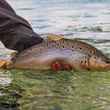Thanks to the efforts of U.S. Sen. Jon Ossoff, a Democrat from Georgia, the fragile hydrological balance of the Okefenokee National Wildlife Refuge will remain intact, at least for the time being. Ossoff, who beat incumbent David Perdue in the 2020 general election, made the protection of the country’s largest blackwater swamp an early-term priority. Shortly after being elected, Ossoff led a team of biologists and scientists from the U.S. Fish and Wildlife Service and the U.S. Army Corps of Engineers on a fact-finding mission to the refuge to determine the potential impacts a proposed titanium and zirconium mine might have on the swamp’s plumbing. And just last week, at Ossoff’s urging, the USACE pulled a mining permit from the Twin Pines Mining Co. of Alabama – the company, if it still wishes to mine the sand ridges near the refuge, must start from scratch.
The Okefenokee might best be described as a giant rain barrel that fills up thanks almost solely to regional rainwater. And this rain barrel has two “spouts”–one spills over into the fabled Suwanee River that flows into northern Florida and eventually into the Gulf of Mexico. The second spout empties into Georgia’s St. Mary’s River, where it drains to the Atlantic.
The proposed Twin Pines mine would be situated near the southeast boundary of the refuge – the company wants to mine the fine sand that serves as the edges of the swamp’s rain barrel. Just a couple of years ago, thanks to the Trump administration’s abandonment of the Waters of the U.S. rule that prohibited most wetland development efforts without federal approval, the mine looked like a sure thing. Without the federal rule in place, the supervising permitting agency was the Georgia Department of Environmental Protection with input from Charlton County. But, just as Ossoff won in 2020, Trump lost, and the new Biden administration reinstated the WOTUS rules. Now, with its mining permit pulled by the USACE, the company, if it still chooses to mine, must do so under the federal application process.
“For the last year, I’ve fought relentlessly to protect the Okefenokee from destruction,” Ossoff said. “I am pleased to announce the restoration of protection for this wildlife refuge and its surrounding wetlands. The Okefenokee is a natural wonder and one of Georgia’s most precious lands. I will continue fighting to protect it for future generations.”
Ecologically, the swamp is vital to the health of both of the rivers it creates, and to a host of wildlife in the region–the Okefenokee consists of almost 400.000 acres of federally designated wilderness that’s home to some 15,000 alligators. It’s also home to river otters, black bears, white-tail deer, rare red cockaded woodpeckers, several carnivorous plant species and more migratory waterfowl than one could reasonably imagine.
What’s more, it’s a unique fishery that fly anglers are just starting to get their heads around. The tannic swamp isn’t great habitat for “traditional” Georgia game fish like largemouth bass, crappie and panfish. Instead, it’s home to more primal denizens like chain pickerel, longnose gar and the predatory bowfin.
The latter is slowly building a cult following among long-rodders. It’s an aggressive ambush predator and it readily hits flies. It’s a brute once it’s hooked – it’ll go on long runs and often jump from the water like bass or even tarpon. It’s a prehistoric “bimodal” breather – like its cousin, the gar, the bowfin can gulp air when dissolved oxygen levels in the water are low.
Since the swamp is the genesis of two important rivers, its health trickles down and impacts the rivers on their course to their respective estuaries. The Suwanee’s course stretches 246 miles to the Gulf of Mexico, and the St. Mary’s River creates the border between Georgia and Florida for about 236 miles before it flows into the Atlantic just north of Jacksonville. Both estuaries are home to threatened Florida manatees, and both blackwater rivers are productive fisheries, particularly for recreational anglers who chase anything from redfish and snook to speckled trout and tripletail.
The Suwanee is also home to endangered gulf sturgeon, a long-lived native that’s listed as threatened under the Endangered Species Act. Aside from climate change which is warming and diminishing habitat, the sturgeon is also susceptible to pollution from agricultural runoff, dam construction and mining discharge.
And, of course, there’s the swamp itself that would be at risk. It’s important from a cultural perspective. Its first inhabitants were from the Muskogee (Creek) Nation and its name in Muskogee is “land of trembling earth.” Later, after Europeans moved into the region, the swamp provided 400 million board feet of pond cypress timber. In 1936, President Franklin Roosevelt designated the swamp as a national refuge. Since then, the refuge’s native cypress have largely returned, and habitat for the area’s wildlife is unmatched in the Southeast.
Presently, the refuge is operated by the U.S. Fish and Wildlife Service and it is popular with anglers, kayakers and canoeists all year long.
“Sen. Ossoff first visited the Okefenokee within his first months in office to observe its impact on our local community and economy,” said Kim Bednarek, executive director of Okefenokee Swamp Park in Waycross, Ga. “Sen. Ossoff is delivering on his promise to our community by protecting and investing in the health of the Okefenokee. We are proud to have worked with the senator and his team to save our refuge.”
































Comments